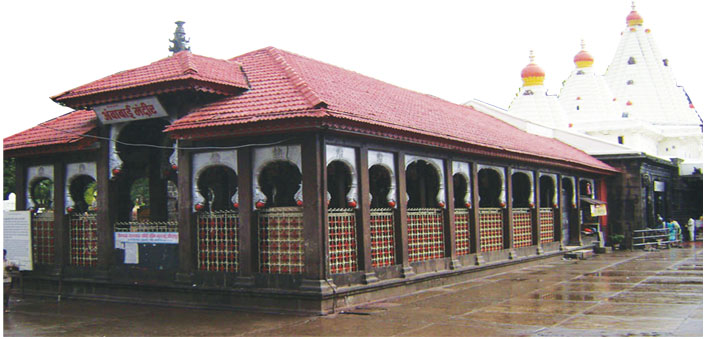Text and photos: Text: Anvi Mehta
OKing of Mountains! I am saying this out of affection for my Bhakts. There is a great place of pilgrimage named Kollapura in the southern country. Here the devi Ambabai always dwells.”
This text is a rough translation from the Devi Gita, and the place of worship mentioned is the modern day city of Kolhapur. The temple which is a Shakti peetha (a place associated with the goddess of power, Shakti) is located in the centre of the city, and is a major tourist attraction. It is said to have been constructed by the demons when Goddess Mahalaxmi left Vaikuntha and arrived in Kolhapur, after a fight with her husband Lord Vishnu. It is said to have been made in a single night and carved out from a single rock mass.
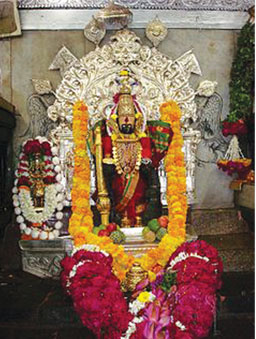
The temple is the first thing to visit in the itinerary of every tourist. Most of the pilgrims visit the Mahalaxmi Temple after taking their blessings from Tirupati in the south, it is said that the pilgrimage is complete only after taking blessings from the Goddess. The best time to visit the temple is either during the Kiranotsav, in which the sun’s position is such that the rays touch the feet of the idol during sunrise. This happens twice a year, generally during the months of January and November. Also, Navratri is a good time to visit as the temple is decorated with glittering lights and diyas, the idol is brought out during the evenings on each of the ten days and taken around the temple premises in a palkhi. The idol is decorated differently with coloured saris and flowers during the procession. Other than the religious importance, the Mahalaxmi temple is a sight to see for anyone interested in architecture or archaeology.
The royal abode
Apart from the temple, the New Palace is another must-visit. The palace was built in the late 1800’s and has paintings of Shivaji Maharaj’s life stories. The palace has a garden area, a museum, a wrestling ground and a small lake within its premises. As the city was one of the important administrative centres for the Chattrapatis, the museum has a lot of memorabilia including college certificates of kings and princes, pictures of the royal family, letters from eminent personalities, old maps and family trees of royal families in the state. It also has a few personal belongings of the kings and queens of the Maratha clan like their clothes, weapons, games, furniture and jewellery. There is also a room which displays stuffed, all the animals and birds the king and his family members have hunted from all over the world. There are stuffed tiger heads, wild bulls, deer species, Himalayan Black Bear and panthers, to name a few. The main attraction is the darbar hall which has the throne at one end of the room, its glory intact despite passing time.
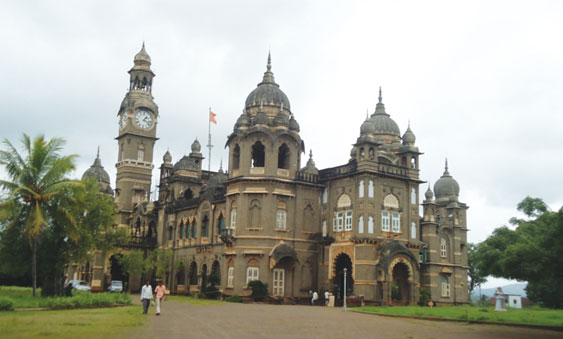
The royal family continues to live in one part of the palace, the descendants of Shreemant Chattrapati Shahu Maharaj have their private chambers in the palace. The palace takes us back to the era when the royals ruled our country.
The river banks
The banks of the Panchganga river are another place of worship for many pilgrims. The river is formed at Prayag Chikli with the confluence of four streams Kasari, Kumbhi, Tulsi and Bhogawati. It is said that the River Saraswati flows underground and joins the confluence.
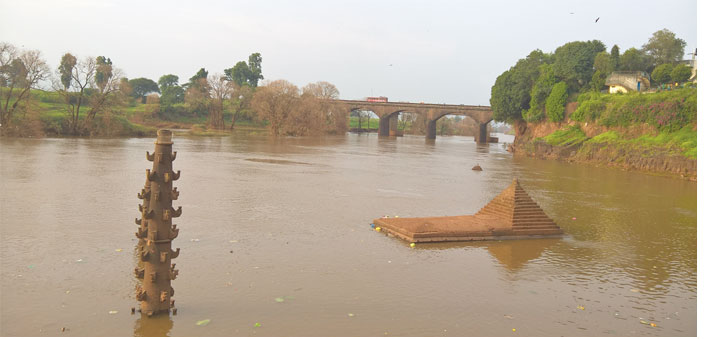
The river bank has a temple of Lord Ganesha, Lord Shiva and Goddess Shakti. It also has an old spiritual centre built for the sages during the time of Shivaji. The best time to visit is during Deepotsav when thousands of diyas float in the river. This happens during Diwali and was started a few years back to gather the community, and attract tourists.
Ahead of the banks is the road towards the famous hill stations Panhala and Jyotiba. The former is known for the fort used by Shivaji himself, the latter is a place of worship. This is a sneak peak to the historical and religious importance of the city. It is because of this rich heritage that the city has a good reputation for its art and culture. But if you visit the city now, the growing urbanisation and modern lifestyle is slowly taking over the ancient arts and practices in the city. Before the heritage is lost in time, one must move past the temples and palaces and experience the local culture by visiting a few hubs.
The colourful chappal lane
The Kolhapuri Paythan, better known as Kolhapuri Chappal, is a leather footwear which is quite a rage in the fashion industry even today, both national and international. One can often see designers pairing traditional outfits with these chappals. They are made from animal skin, mainly buffalo, and are handcrafted. The USP (Unique Selling Point) of this chappal is that the leather is tanned using vegetable dyes and not chemical dyes. This is a practice continued since they were manufactured for the first time.
The city’s chappal lane is near the temple. It is a 500 meter road stretch with shops on both sides. One can smell the leather, its polish from meters before the road begins. A typical Kolhapuri Chappal is heavy leather footwear which has a lot of straps in the front, usually decorated with threads from the animal skin. Over a period of time, the chappal has been modified and made into lighter footwear with only thin straps.
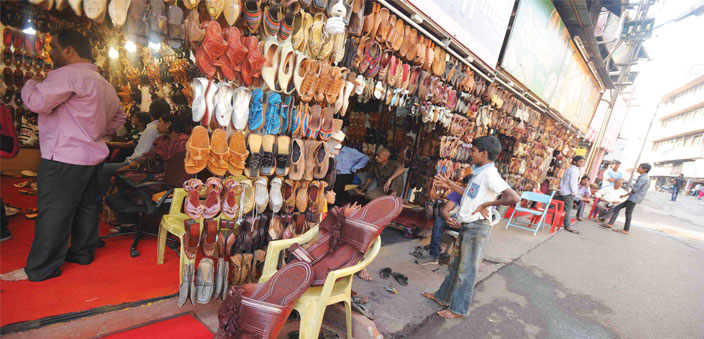
“The Kolhapuri Chappals are said to have been made first during the 13th century. It was a specific community known as the chambhars (cobblers) who specialised in making these chappals. The chappals made for the royals and the military were heavy, and made a chirpy sound while walking”, said Jaysinghrao Powar who owns one of the oldest stores in the chappal lane. Depending on the quality and make, chappals vary from `200 to a lakh. One needs to have great bargaining skills here as store owners often end up quoting more than the actual price.
Buying a pair of chappals is a good experience, but seeing a pair being made, is a better one. One must definitely try to visit one of the small-scale manufacturing units in the city. Any store owner in the lane will help with a visit to one of these units. These small units are generally owned by the higher strata of the chambhar communities. The artists are usually of the economically lower strata that are skilled in making the footwear since their childhood. One can see three different groups of artists – one is responsible for tying the threads removed from the hide to create intricate designs for the top of the chappal, the second group works on the polishing and cutting of the leather to make the base, and the third one usually takes care of the finishing. Artists are paid anything between ` 50 to ` 350 for a pair. It is an unusual tourist experience to actually see the artists at work.
Increasing demand, but a dying art
While everything looks fine for the chappals, the art of making this leather footwear is dying. The owner of a small establishment, Namdev Kadam explained that there are very few artists who make the chappals. The older generations of the cobbler community are losing efficiency with age and the newer generations do not want to learn this skill. As it is a daily wage profession, people are losing interest in it. Families are opting to educate their children over teaching them this ancestral art.
“Making a chappal is a work of art. The thread work is intricate and need a lot of focus to get the perfection. Compared to the work done, the artists get paid very less. This is one reason why people are drifting away from this job. They are getting educated and trying for jobs that pay better than this sedentary job. The community should set up a training centre and decide on a monthly salary instead of the daily wages. This will bring back the younger generations to this art, which their families are involved in for hundreds of years,” said Kadam.
As per shop owners, beef banning in the state has caused a major setback in the Kolhapur chappal industry. The sellers have to import the leather from Kerala. This has brought down the quality of the leather. Manufacturers are also no longer able to order leather as per their requirements. It is because of these two major reasons that the art which has demand, is at the brink of extinction. Though the footwear is available in stores and on online markets, the make and quality is dropping with each passing day. Fewer artists who make these chappals the traditional way remain, elders predicting the footwear art will last not more than 10 years from now. The story of the Kolhapuri Paythan needs to be propagated to ensure that some steps are taken to revive this old art, and train younger generations.
The last stone-carving centre
It is said that the Mahalaxmi Temple was hand-carved from a single mass of stone, right from the numerous pillars supporting the structure, to the delicate designs on them.
Probably this is one reason why one can find a lot of temples made from stones with hand-carved designs. The stones used to build these temples are also chiselled using hand tools only. This is an art common to the state of Maharashtra, Kolhapur being one of the biggest hubs.
On the Kolhapur-Panhala highway, a lot of stone carving artists can be seen on the side of the road. They belong to the village of Keral, and they generally make small hand-carved stone idols. These stone carving workshops have now become hybrid – that is, they use both machinery and hand tools to carve designs on the stones. Most of their work is used for temples being constructed in nearby areas.
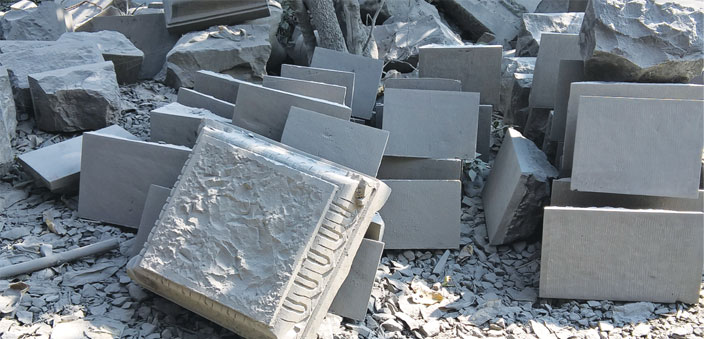
But, to know more about the art, one must visit one of the last stone carving workshops in the city. At Dussera Chowk is the workshop of Ganpatrao Udhale. It is the largest space where stone is cut, polished and carved using hand tools. There are a few artists of the Vadar community who specialise in stone carving. They are usually seen carving mythical creatures, holy symbols and flower designs on large pieces of stones. While a few years back everything was done by hand chisels and hammer, these days the workshop has installed a cutter for the initial stage. The designing is still done using hand tools.
A few decades earlier, the whole area of Dussera Chowk was occupied by large workshops, there was a high demand for these stones in the construction of temples, buildings and idols. As cement concrete began replacing the stones, the workshops started closing down one by one. For the last two years, this is the only workshop operating continuously. Where stone carving is concerned, the main reason for its decline is the lack of demand. With not much demand in market and less income, the younger generations of the Vadar community are leaning toward other better paying jobs.
“The art of stone carving is very difficult. It needs a lot of skill and patience. The younger generations want quick money and they want to learn other skills than this. Also, there is not much market for this. If only the newer constructions start using the carved stones to give their buildings a heritage touch to it, it may solve a lot of problems”, said Udhale. Stone carving is also found in the northern and western parts of the state, but most of the workshops have converted to machine-based ones.
‘Dangal’ in the city
Recently, there were two movies based on wrestling, both starring superstars. The movies have shed some light on wrestling and its situation in our country. Very few people know that the city of Kolhapur is also known for its wrestlers and wrestling groups. Talim mandals as they are called, are groups of men practising wrestling everyday morning. ‘Kushti’ is a sport locally famous, youngsters from faraway villages come to the city to get trained.
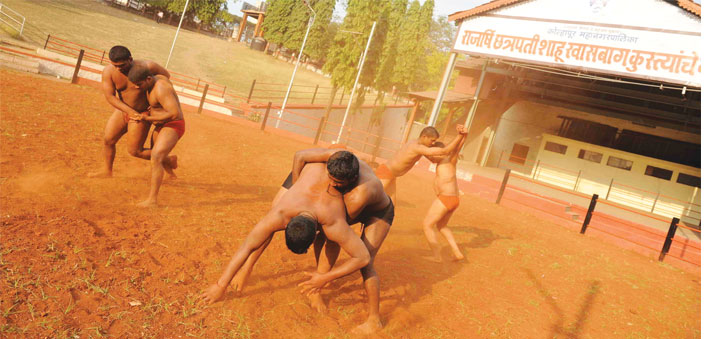
To see the oil clad men wrestle with each other in red mud, one must visit the Khasbaag Maidan. It is the hub where most of the practice as well as the matches take place. The best time to visit is either early morning or evenings, when you can see the wrestlers exercise, relish their diet of milk and eggs, and practice kushti in the mud wearing langotis – a sight that will definitely remind you of the movies. If not the Khasbaag, you can visit any talims (groups) that train wrestlers. Most of these talims are in and around the temple area.
While the movies are propagating wrestling, in the city it is on a decline. Youngsters are finding gyms a cooler and modern way of working out than wrestling. Also, the sport is not earning them enough money to survive in this competitive world. Probably a lot more ‘dangal’ is needed to save this sport from dying.
Conclusion
The arts mentioned above are the ‘essence of the culture of Kolhapur. While visiting the tourist places is important, feeling the culture of the city is a new experience altogether. This is heritage that we need to see, get inspired and preserve.

